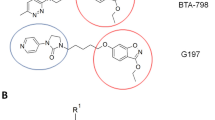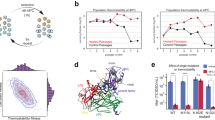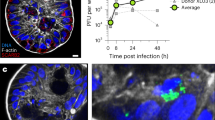Abstract
Enterovirus 71 (EV71) is a major agent of hand, foot and mouth disease in children that can cause severe central nervous system disease and death. No vaccine or antiviral therapy is available. High-resolution structural analysis of the mature virus and natural empty particles shows that the mature virus is structurally similar to other enteroviruses. In contrast, the empty particles are markedly expanded and resemble elusive enterovirus-uncoating intermediates not previously characterized in atomic detail. Hydrophobic pockets in the EV71 capsid are collapsed in this expanded particle, providing a detailed explanation of the mechanism for receptor-binding triggered virus uncoating. These structures provide a model for enterovirus uncoating in which the VP1 GH loop acts as an adaptor-sensor for cellular receptor attachment, converting heterologous inputs to a generic uncoating mechanism, highlighting new opportunities for therapeutic intervention.
This is a preview of subscription content, access via your institution
Access options
Subscribe to this journal
Receive 12 print issues and online access
209,00 € per year
only 17,42 € per issue
Buy this article
- Purchase on SpringerLink
- Instant access to full article PDF
Prices may be subject to local taxes which are calculated during checkout




Similar content being viewed by others
References
Brown, B.A. & Pallansch, M.A. Complete nucleotide sequence of enterovirus 71 is distinct from poliovirus. Virus Res. 39, 195–205 (1995).
McMinn, P.C. An overview of the evolution of enterovirus 71 and its clinical and public health significance. FEMS Microbiol. Rev. 26, 91–107 (2002).
Wu, Y. et al. Structures of EV71 RNA-dependent RNA polymerase in complex with substrate and analogue provide a drug target against the hand-foot-and-mouth disease pandemic in China. Protein Cell 1, 491–500 (2010).
Basavappa, R. et al. Role and mechanism of the maturation cleavage of VP0 in poliovirus assembly: structure of the empty capsid assembly intermediate at 2.9 resolution. Protein Sci. 3, 1651–1669 (1994).
Curry, S. et al. Dissecting the roles of VP0 cleavage and RNA packaging in picornavirus capsid stabilization: the structure of empty capsids of foot-and-mouth disease virus. J. Virol. 71, 9743–9752 (1997).
Tuthill, T.J., Groppelli, E., Hogle, J.M. & Rowlands, D.J. Picornaviruses. Curr. Top. Microbiol. Immunol. 343, 43–89 (2010).
Ansardi, D.C. & Morrow, C.D. Amino acid substitutions in the poliovirus maturation cleavage site affect assembly and result in accumulation of provirions. J. Virol. 69, 1540–1547 (1995).
Jacobson, M.F. & Baltimore, D. Morphogenesis of poliovirus. I. Association of the viral RNA with coat protein. J. Mol. Biol. 33, 369–378 (1968).
Liu, C.C. et al. Purification and characterization of enterovirus 71 viral particles produced from Vero cells grown in a serum-free microcarrier bioreactor system. PLoS ONE 6, e20005 (2011).
Guttman, N. & Baltimore, D. A plasma membrane component able to bind and alter virions of poliovirus type 1: studies on cell-free alteration using a simplified assay. Virology 82, 25–36 (1977).
Marongiu, M.E., Pani, A., Corrias, M.V., Sau, M. & La Colla, P. Poliovirus morphogenesis. I. Identification of 80S dissociable particles and evidence for the artifactual production of procapsids. J. Virol. 39, 341–347 (1981).
Le Bouvier, G.L. The modification of poliovirus antigens by heat and ultraviolet light. Lancet 269, 1013–1016 (1955).
Blondel, B., Akacem, O., Crainic, R., Couillin, P. & Horodniceanu, F. Detection by monoclonal antibodies of an antigenic determinant critical for poliovirus neutralization present on VP1 and on heat-inactivated virions. Virology 126, 707–710 (1983).
Hogle, J.M. Poliovirus cell entry: common structural themes in viral cell entry pathways. Annu. Rev. Microbiol. 56, 677–702 (2002).
Olson, N.H. et al. Structure of a human rhinovirus complexed with its receptor molecule. Proc. Natl. Acad. Sci. USA 90, 507–511 (1993).
Rossmann, M.G. et al. Structure of a human common cold virus and functional relationship to other picornaviruses. Nature 317, 145–153 (1985).
Zhang, P. et al. Crystal structure of CD155 and electron microscopic studies of its complexes with polioviruses. Proc. Natl. Acad. Sci. USA 105, 18284–18289 (2008).
Crowell, R.L. & Philipson, L. Specific alterations of coxsackievirus B3 eluted from HeLa cells. J. Virol. 8, 509–515 (1971).
Kaplan, G. et al. Identification of a surface glycoprotein on African green monkey kidney cells as a receptor for hepatitis A virus. EMBO J. 15, 4282–4296 (1996).
Lonberg-Holm, K., Gosser, L.B. & Kauer, J.C. Early alteration of poliovirus in infected cells and its specific inhibition. J. Gen. Virol. 27, 329–342 (1975).
Fricks, C.E. & Hogle, J.M. Cell-induced conformational change in poliovirus: externalization of the amino terminus of VP1 is responsible for liposome binding. J. Virol. 64, 1934–1945 (1990).
Greve, J.M. et al. Mechanisms of receptor-mediated rhinovirus neutralization defined by two soluble forms of ICAM-1. J. Virol. 65, 6015–6023 (1991).
Bostina, M., Levy, H., Filman, D.J. & Hogle, J.M. Poliovirus RNA is released from the capsid near a twofold symmetry axis. J. Virol. 85, 776–783 (2011).
Bubeck, D. et al. The structure of the poliovirus 135S cell entry intermediate at 10-angstrom resolution reveals the ___location of an externalized polypeptide that binds to membranes. J. Virol. 79, 7745–7755 (2005).
Levy, H.C., Bostina, M., Filman, D.J. & Hogle, J.M. Catching a virus in the act of RNA release: a novel poliovirus uncoating intermediate characterized by cryo-electron microscopy. J. Virol. 84, 4426–4441 (2010).
Hendry, E. et al. The crystal structure of coxsackievirus A9: new insights into the uncoating mechanisms of enteroviruses. Structure 7, 1527–1538 (1999).
Belnap, D.M. et al. Molecular tectonic model of virus structural transitions: the putative cell entry states of poliovirus. J. Virol. 74, 1342–1354 (2000).
Siebert, X. & Navaza, J. UROX 2.0: an interactive tool for fitting atomic models into electron-microscopy reconstructions. Acta Crystallogr. D Biol. Crystallogr. 65, 651–658 (2009).
Filman, D.J. et al. Structural factors that control conformational transitions and serotype specificity in type 3 poliovirus. EMBO J. 8, 1567–1579 (1989).
Grant, R.A. et al. Structures of poliovirus complexes with anti-viral drugs: implications for viral stability and drug design. Curr. Biol. 4, 784–797 (1994).
Smith, T.J. et al. The site of attachment in human rhinovirus 14 for antiviral agents that inhibit uncoating. Science 233, 1286–1293 (1986).
McSharry, J.J., Caliguiri, L.A. & Eggers, H.J. Inhibition of uncoating of poliovirus by arildone, a new antiviral drug. Virology 97, 307–315 (1979).
Hogle, J.M., Chow, M. & Filman, D.J. Three-dimensional structure of poliovirus at 2.9Å resolution. Science 229, 1358–1365 (1985).
Smyth, M. et al. Implications for viral uncoating from the structure of bovine enterovirus. Nat. Struct. Biol. 2, 224–231 (1995).
Foo, D.G. et al. Identification of neutralizing linear epitopes from the VP1 capsid protein of Enterovirus 71 using synthetic peptides. Virus Res. 125, 61–68 (2007).
Liu, C.C. et al. Identification and characterization of a cross-neutralization epitope of Enterovirus 71. Vaccine 29, 4362–4372 (2011).
Yang, S.L., Chou, Y.T., Wu, C.N. & Ho, M.S. Annexin II binds to capsid protein VP1 of enterovirus 71 and enhances viral infectivity. J. Virol. 85, 11809–11820 (2011).
Nishimura, Y. et al. Human P-selectin glycoprotein ligand-1 is a functional receptor for enterovirus 71. Nat. Med. 15, 794–797 (2009).
Yamayoshi, S. et al. Scavenger receptor B2 is a cellular receptor for enterovirus 71. Nat. Med. 15, 798–801 (2009).
Rossmann, M.G., He, Y. & Kuhn, R.J. Picornavirus-receptor interactions. Trends Microbiol. 10, 324–331 (2002).
He, Y. et al. Complexes of poliovirus serotypes with their common cellular receptor, CD155. J. Virol. 77, 4827–4835 (2003).
Xiao, C. et al. The crystal structure of coxsackievirus A21 and its interaction with ICAM-1. Structure 13, 1019–1033 (2005).
Oliveira, M.A. et al. The structure of human rhinovirus 16. Structure 1, 51–68 (1993).
Kim, S. et al. Conformational variability of a picornavirus capsid: pH-dependent structural changes of Mengo virus related to its host receptor attachment site and disassembly. Virology 175, 176–190 (1990).
McDermott, B.M. Jr., Rux, A.H., Eisenberg, R.J., Cohen, G.H. & Racaniello, V.R. Two distinct binding affinities of poliovirus for its cellular receptor. J. Biol. Chem. 275, 23089–23096 (2000).
Giranda, V.L. et al. Acid-induced structural changes in human rhinovirus 14: possible role in uncoating. Proc. Natl. Acad. Sci. USA 89, 10213–10217 (1992).
Davis, M.P. et al. Recombinant VP4 of human rhinovirus induces permeability in model membranes. J. Virol. 82, 4169–4174 (2008).
Racaniello, V.R. Early events in poliovirus infection: virus-receptor interactions. Proc. Natl. Acad. Sci. USA 93, 11378–11381 (1996).
Lin, J. et al. An externalized polypeptide partitions between two distinct sites on genome-released poliovirus particles. J. Virol. 85, 9974–9983 (2011).
Kay, B.K., Williamson, M.P. & Sudol, M. The importance of being proline: the interaction of proline-rich motifs in signaling proteins with their cognate domains. FASEB J. 14, 231–241 (2000).
Stuart, D.I., Levine, M., Muirhead, H. & Stammers, D.K. Crystal structure of cat muscle pyruvate kinase at a resolution of 2.6Å. J. Mol. Biol. 134, 109–142 (1979).
Walter, T.S. et al. A procedure for setting up high-throughput nanolitre crystallization experiments. Crystallization workflow for initial screening, automated storage, imaging and optimization. Acta Crystallogr. D Biol. Crystallogr. 61, 651–657 (2005).
Axford, D. et al. In situ macromolecular crystallography using microbeams. Acta Crystallogr. D Biol. Crystallogr. (in the press).
Borek, D., Cymborowski, M., Machius, M., Minor, W. & Otwinowski, Z. Diffraction data analysis in the presence of radiation damage. Acta Crystallogr. D Biol. Crystallogr. 66, 426–436 (2010).
Brünger, A.T. et al. Crystallography & NMR system: a new software suite for macromolecular structure determination. Acta Crystallogr. D Biol. Crystallogr. 54, 905–921 (1998).
Emsley, P., Lohkamp, B., Scott, W.G. & Cowtan, K. Features and development of Coot. Acta Crystallogr. D Biol. Crystallogr. 66, 486–501 (2010).
Blanc, E. et al. Refinement of severely incomplete structures with maximum likelihood in BUSTER-TNT. Acta Crystallogr. D Biol. Crystallogr. 60, 2210–2221 (2004).
Laskowski, R.A., Moss, D.S. & Thornton, J.M. Main-chain bond lengths and bond angles in protein structures. J. Mol. Biol. 231, 1049–1067 (1993).
Acknowledgements
We thank Sinovac Biotech Ltd. and the China National Biotech Group for providing virus samples, R. Gilbert for assistance with analytical ultracentrifugation, R. Esnouf for help with pocket analysis, J. Grimes for various help, especially with VEDA, and A. Kotecha for assistance with Diamond data collection. We also thank the Photon Factory, Japan, and the National Synchrotron Radiation Laboratory (NSRL), China. Work was supported by the National Major Project of Infectious Disease, the Ministry of Science and the Technology 973 Project (grant no. 2007CB914304). D.I.S., E.E.F. and T.S.W. are supported by the UK Medical Research Council, J.R. by the Wellcome Trust and C.P. by the Department for Environment, Food and Rural Affairs (DEFRA, UK).
Author information
Authors and Affiliations
Contributions
J.W., Z.H., W.Y. and X.S. prepared samples; X.W., W.P., X.L., Z.L., J.X., J.R., C.P., G.E., D.A., R.O., T.S.W., E.E.F. and D.I.S. performed research; W.P., X.W., Z.L., J.R., E.E.F. and D.I.S. analyzed data and, with D.J.R. and Z.R., wrote the manuscript, in discussion with J.W., Z.H., W.Y. and X.S.; all authors contributed to experimental design; Z.R. and D.I.S. supervised the project.
Corresponding authors
Ethics declarations
Competing interests
The authors declare no competing financial interests.
Supplementary information
Supplementary Text and Figures
Supplementary Figures 1–7 and Supplementary Table 1 (PDF 10558 kb)
Rights and permissions
About this article
Cite this article
Wang, X., Peng, W., Ren, J. et al. A sensor-adaptor mechanism for enterovirus uncoating from structures of EV71. Nat Struct Mol Biol 19, 424–429 (2012). https://doi.org/10.1038/nsmb.2255
Received:
Accepted:
Published:
Issue Date:
DOI: https://doi.org/10.1038/nsmb.2255
This article is cited by
-
Stomach as the target organ of Rickettsia heilongjiangensis infection in C57BL/6 mice identified by click chemistry
Communications Biology (2024)
-
Current status of hand-foot-and-mouth disease
Journal of Biomedical Science (2023)
-
Global emergence of Enterovirus 71: a systematic review
Beni-Suef University Journal of Basic and Applied Sciences (2022)
-
Transcriptome of human neuroblastoma SH-SY5Y cells in response to 2B protein of enterovirus-A71
Scientific Reports (2022)
-
Cryo-electron microscopy and image classification reveal the existence and structure of the coxsackievirus A6 virion
Communications Biology (2022)



